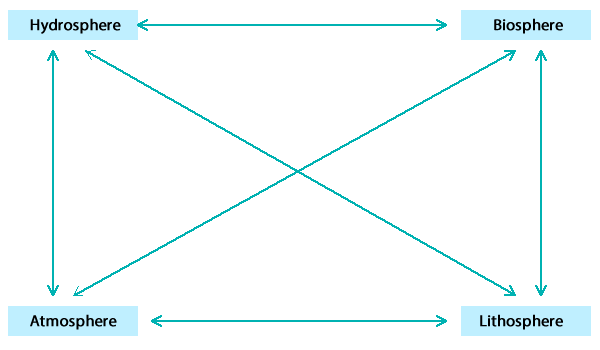Intertidal Wetlands - Biophysical Interactions
The ways in which the four spheres interact is critical in determining the extent and nature of intertidal wetlands.
Atmosphere: Microclimates are created e.g. air temperature higher in salt marshes than mangroves; minimal wind movement in mangroves; humidity is generally high; gases are created via the lithosphere e.g. sulfide and nitrogen.
Hydrosphere: Salinity levels vary with tides and floods. Water movement is slowed by vegetation. Biosphere adds to store of nutrients in the water. The atmosphere contributes gases that are found in water.Erosion of soils results in levels of water turbidity.
Lithosphere: Small soil particle size; soil is often of a clay mix; vegetation adds to the organic nature of the soils; salinity level of the soil varies with rainfall. The biosphere's organisms recycle nutrients in the lithosphere.
Biosphere: High faunal diversity – low flora diversity, but are highly adapted to the conditions presented by the other spheres.
The distribution and types of species are affected by all of the above. The atmosphere contributes the climate required to support life in intertidal wetlands. The hydrosphere provides the waterlogged and slightly alkaline conditions required for the survival of wetland organisms.
Atmosphere: Microclimates are created e.g. air temperature higher in salt marshes than mangroves; minimal wind movement in mangroves; humidity is generally high; gases are created via the lithosphere e.g. sulfide and nitrogen.
Hydrosphere: Salinity levels vary with tides and floods. Water movement is slowed by vegetation. Biosphere adds to store of nutrients in the water. The atmosphere contributes gases that are found in water.Erosion of soils results in levels of water turbidity.
Lithosphere: Small soil particle size; soil is often of a clay mix; vegetation adds to the organic nature of the soils; salinity level of the soil varies with rainfall. The biosphere's organisms recycle nutrients in the lithosphere.
Biosphere: High faunal diversity – low flora diversity, but are highly adapted to the conditions presented by the other spheres.
The distribution and types of species are affected by all of the above. The atmosphere contributes the climate required to support life in intertidal wetlands. The hydrosphere provides the waterlogged and slightly alkaline conditions required for the survival of wetland organisms.
| 12g_-_ear_-_wetlands_matching.doc |

